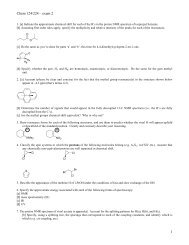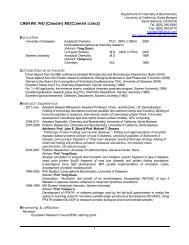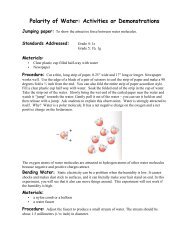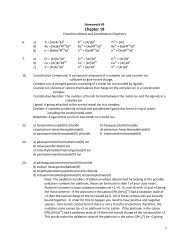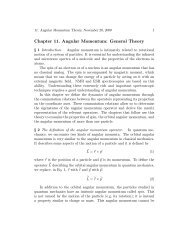Chapter 7. The Eigenvalue Problem
Chapter 7. The Eigenvalue Problem
Chapter 7. The Eigenvalue Problem
You also want an ePaper? Increase the reach of your titles
YUMPU automatically turns print PDFs into web optimized ePapers that Google loves.
<strong>7.</strong> <strong>The</strong> <strong>Eigenvalue</strong> <strong>Problem</strong>, December 17, 2009 25<br />
Exercise 9 For x = {−a − b, a, b}, testthatMx =0x and x · s(1) = 0.<br />
To get two non-zero eigenvectors corresponding to the eigenvalue λ =0,<br />
I first pick arbitrarily x 2 (2) = 1 and x 3 (2) = 2, and obtain (from the general<br />
form in Eq. 134)<br />
x(2) = {−3, 1, 2} (135)<br />
<strong>The</strong>n I pick a second vector by choosing arbitrarily 1 x 2 (3) = 0 and x 3 (3) = 1<br />
and obtain<br />
x(3) = {−1, 0, 1} (136)<br />
Physics requires that these two vectors be normalized and orthogonal. <strong>The</strong><br />
Gram-Schmidt procedure will make them orthogonal, and the orthogonalized<br />
eigenvectors are<br />
v(2) = x(2) = {−3, 1, 2} (137)<br />
<br />
v(2)<br />
1<br />
v(3) = x(3) −<br />
v(2) | v(2) v(2) | x(3) = 14 , − 5<br />
14 , 2 <br />
(138)<br />
7<br />
Exercise 10 Show that s(1) | v(2) = s(1) | v(3) = v(2) | v(3) =0and<br />
Mv(i) =0v(i) fori =2, 3.<br />
<strong>The</strong> vectors v(2) and v(3) are not normalized. <strong>The</strong> respective normalized<br />
eigenvectors are<br />
s(2) =<br />
<br />
v(2)<br />
= −√ 3 ,<br />
v(2) | v(2) 14<br />
1<br />
√<br />
14<br />
,<br />
<br />
2<br />
√<br />
14<br />
(139)<br />
s(3) =<br />
<br />
v(3) 1<br />
<br />
v(3) | v(3) = √ , −√ 5 , 2√ <br />
2<br />
√<br />
42 42 21<br />
(140)<br />
<strong>The</strong>se vectors s(2) and s(3) are degenerate eigenvectors corresponding to the<br />
eigenvalues λ 2 = λ 3 = 0. <strong>The</strong> system {s(1), s(2), s(3)} is orthonormal.<br />
How does the degenerate problem differ from the non-degenerate one<br />
For a non-degenerate eigenvalue, we lose an equation and we can solve the<br />
1 or almost so: make sure not to choose a multiple of the first vector




